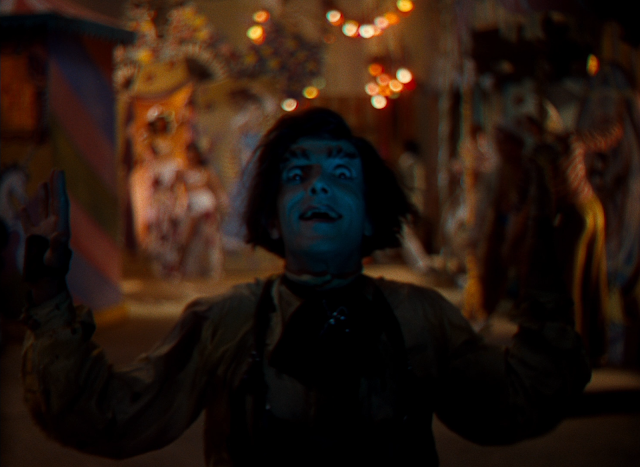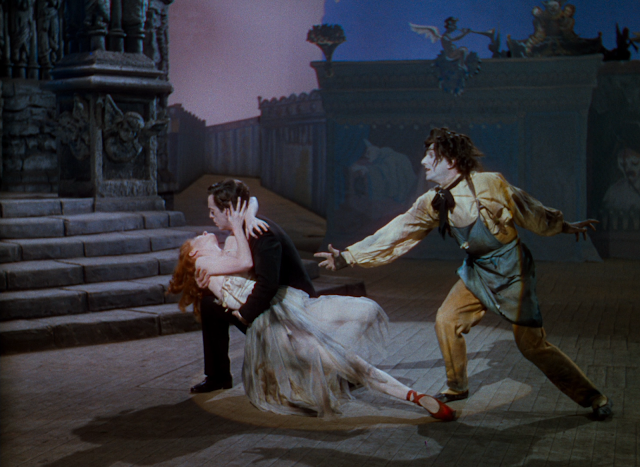Week Thirty-Two: The Red Shoes (1948)
Producers: Michael Powell and Emeric Pressburger
Writers: Michael Powell, Emeric Pressburger, and Keith Winter
Cinematography: Jack Cardiff
Music: Brian Easdale
Choreography: Robert Helpmann and Léonide Massine
Starring: Moira Shearer (Vicky Page), Marius Goring (Julian Craster), Anton Walbrook (Boris Lermontov), Léonide Massine (Gischa Ljubov), Robert Helpmann (Ivan Boleslawsky), Albert Bassermann (Sergei Ratov), Ludmilla Tchérina (Irina Boronskaya), Esmond Knight (Livy Montague), Austin Trevor (Professor Palmer), Jean Short (Terry), Gordon Littman (Ike), Eric Berry (Dimitri), Irene Brown (Lady Neston)
Throughout the thirties and forties, musicals mostly focused on the popular forms of dancing: tap and an amalgamation of ballroom, waltzes, foxtrots, and tangos that were essential for the “American Style” of dancing. Ballet was a “higher” form of dance generally considered along with opera to be too highbrow for the average audiences that made up the bulk of paying customers. However, in short bursts ballet had an appeal, mostly as one-off novelty acts in musicals. The Astaire/Rogers vehicle Shall We Dance (1937) featured dancer Harriet Hoctor performing “Hoctor’s Ballet,” elements of which Astaire incorporated into his following number. Astaire continued to incorporate ballet into his performances – “Limehouse Blues” (Ziegfeld Follies, 1945) and “Dream Ballet” (Yolanda and the Thief, 1945) – but these were still Hollywood musical versions of ballet, nothing that would be recognized as close to real ballet by devotees.
For ballet to make its triumphant entrance into the movies, it wasn’t MGM or any big Hollywood studio taking a risk, instead, it was cinema’s foremost iconoclasts – Michael Powell and Emeric Pressburger – who broke the seal. The Red Shoes isn’t a traditional musical with singing and dancing, it is a backstage drama about a ballet company with a story far more complex than the light fare of Hollywood musicals, even the great Meet Me in St. Louis. Moreover, besides being about ballet itself, The Red Shoes has several ballet performances in it, including a full performance of the mesmerizing “The Red Shoes” Ballet which was written and choreographed for the movie.
“The Red Shoes” ballet – and indeed the entire film – benefits from incredible production design by Hein Heckroth, a close collaborator with Powell and Pressburger. There is so much brilliance in the film that it is hard to know where to start. At times, a creator and a subject are just so perfectly aligned that the results cannot be denied. The combination of art design, costumes, and makeup of The Red Shoes are pretty much unrivaled even in modern movies:
 |
| Hein Heckroth's art design is obviously crucial to the film's ballet sequences... |
 |
| ...but is also crucial in the film's proper, expanding space: note the matte painting in the background. |
 |
| From simple to extravagant, Heckroth's costumes in The Red Shoes are peerless. |
Of course, it helps that this work is presented in some of the most beautifully executed Technicolor photography imaginable. Cinematographer Jack Cardiff – who won an Oscar for his work on Powell and Pressburger's Black Narcissus the previous year – was one of the first British cinematographers to use Technicolor and had by this point become the undisputed master of the medium. We saw in The Life and Death of Colonel Blimp how different Powell and Pressburger’s painterly version of Technicolor was from the primary color “pop” of American Technicolor but both Black Narcissus and The Red Shoes are a step beyond even that. The subtle depth and variation of color in Cardiff’s work are remarkable: he manages to create a wide range of colors that still manage to stand out on their own:
 |
| The Red Shoes creates both beautiful, painterly interiors... |
 |
| ...and vibrant exteriors. |
 |
| The secret to the most stunning looking parts of The Red Shoes? Light. |
 |
| Only one part of the film has that Hollywood Technicolor "pop": the shoes themselves. |
Just as the Technicolor aides the production values of the film, so does Powell’s direction aide the photography. All too often, films relied just on the beauty of Technicolor to create pictorial appeal, ignoring the creative composition of visuals. Powell directs Technicolor as if he were making a black-and-white film, utilizing complex light, framing, and angles to enliven the composition:
After You Watch the Movie (Spoilers Below)
The Red Shoes isn’t just pretty to look at. Like all of Powell and Pressburger’s films, it takes a complex concept – a story about an irresistible obsession itself becoming an irresistible obsession – and executes it flawlessly.
 |
| Obsession: from Lermontov's relentless drive for perfection... |
 |
| ...to Vicky's secret midnight longing to dance. |
The film gives a real sense of immersion into the backstage of the Ballet Lermontov and most brilliantly, to the creative process and the level of dedication, bordering on obsession, that is required of artists at the highest level. For Vicky, Julian represents the way out, a chance to keep dancing some but also share her life and passion with another. On the other hand, Lermontov’s life is dancing and ballet and wants to take Vicky with him down that path: “Sorrow will pass,” he says “life is so unimportant.” That is film’s central conflict, of life vs. art just as the Red Shoes in the ballet are unwilling to never stop dancing despite the girls desire to, so the two halves of Vicky wrestle with choosing between love and dance. Between the shoemaker (Lermontov) and the boyfriend (Julian).
The story of the all-consuming red shoes, not content with residing within the ballet, attaches itself to the very story within which it exists as a created work of art. Whether or not it is her internal conflict of the shoes themselves that kill Vicky, the film does not say, but the fact that that type of question even arises in a film in 1948 is astounding.
 |
| Are the shoes obeying the mind... |
 |
| ...or the mind obeying the shoes? |
 |
| Vicky's death in real life parallel's her character's death in the ballet. |
The Red Shoes, like other Powell and Pressburger films, was far ahead of its time in both concepts and themes. That is before even mentioning the entire ballet sequence, something that was at this point unprecedented in film history. Recordings of ballets existed prior to this, of course, but none were plopped inside a serious psychological romantic drama and even if they were, “The Red Shoes” ballet is much more than that. Rather than just make a beautiful recording of ballet production, The Red Shoes does what movies always should when presenting other mediums: use the inherent advantages of film to create a cinematic interpretation. “The Red Shoes” breaks from what is possible in a conventional stage-bound performance – ala Busby Berkeley musical numbers – and uses camera tricks and cinema’s spatial infinity to create a beautiful, impossible, surreal masterpiece. This is where, of all places, the succession of the Busby Berkeley musical can be found, as the camera and set become an active participant, just as much a part of the dance as the dancers.
 |
| The opening of the ballet establishes the setting and limitations of the stage... |
 |
| ...and the performance begins as a normal stage play... |
 |
| ...but Powell then introduces effects only possible in movies. |
 |
| Once the red shoes become a part of Vicky... |
 |
| ...the ballet quickly descends into the surreal: |
 |
| Even Vicky's own internal struggle becomes a part of the performance. |
 |
| Now completely free of the stage setting, the camera, effects, and sets all become integral parts of the ballet itself: |
It cannot be understated how unusual The Red Shoes – essentially an art film about and starring ballet dancers (Shearer, Helpmann, Massine and many of the other performers were not screen actors) – was at this time. Like the rest of Powell and Pressburger’s output, there wasn’t really anything remotely similar to their films and there never really would be. Decades later Darren Aronofsky revisited the theme of artistic perfection in the ballet with Black Swan (2010) but that film leans much harder into Persona-esque psychological horror than the grand romantic drama of The Red Shoes.
All of this makes the fact that The Red Shoes was a massive hit all the more shocking. Not only was the film successful in its native Britain, but it was also the top grossing film of 1948 in America. By having this level of success, this groundbreaking film about love and obsession in the ballet redefined what a commercially successful film could be. Basically since Hollywood began, studios were afraid that anything too complex or high-brow wouldn’t work with audiences and their output reflected that. With The Red Shoes breaking that trend, it showed that the public could handle far more than they were given credit for.
 |
| A ballet film with wildly artistic elements was not considered commercially viable, but The Red Shoes was a massive hit in America none-the-less |
Three years later Vincente Minnelli’s An American in Paris – which closes with a seventeen-minute long ballet-inspired dance – was a top ten earner at the box office and won Best Picture at the Academy Awards. That celebrated final dance number was only allowed by the studio after Gene Kelly showed them The Red Shoes. Now, a film as unique as The Shape of Water can make nearly $200 million and win Best Picture because of the revolution that The Red Shoes began.
See Also
The Tales of Hoffman (1951) dir. Michael Powell and Emeric Pressburger
A spiritual successor of sorts to The Red Shoes, The Tales of Hoffman is a cinematically stylized adaptation of Jacques Offenbach’s opera of the same name. There is no story outside of the opera. The four primary dancers in The Red Shoes return, as does Heckroth and beautiful Technicolor, though this time by Christopher Challis. If you liked the ballet dances in The Red Shoes, this is the movie for you.
An American in Paris (1951) dir. Vincente Minnelli
Minnelli and Gene Kelly’s tribute to the brilliant music of George Gershwin is stuffed to the gills with one great musical number after another, culminating in the ballet-inspired closing number.
A Star is Born (1954) dir. George Cukor
No ballet but the oft-remade A Star is Born is still an adventurous musical film. Judy Garland stars as an emerging star who must deal with the breakdown of her has-been husband. A dark and tragic film far from the normal light musical comedy story. Features Garland’s last great musical performance, including the classic “The Man That Got Away.”
Black Narcissus (1947) dir. Michael Powell and Emeric Pressburger
Just as unique a film as The Red Shoes, Black Narcissus may be Powell and Pressburger’s greatest film despite the fact that it is about the desires of nuns living in the Himalayas. A strange and moving film that looks just as beautiful as the film that follows it, even if it is in an entirely different way.
Let me know what you think either here or on Twitter @bottlesofsmoke















































Comments
Post a Comment